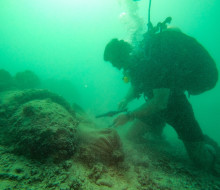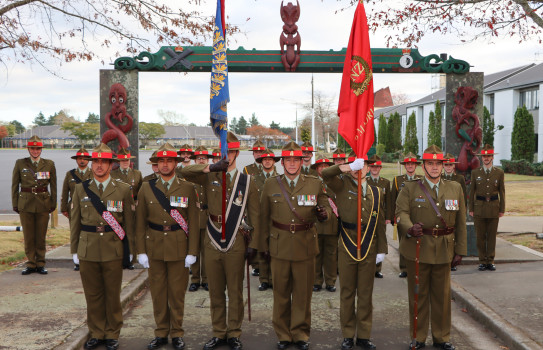
Second World War-era bombs in Vanuatu made safe by Navy divers
26 June 2024
Unfortunately you are viewing this website on an outdated browser which does not support the necessary features for us to provide an adequate experience. Please switch to a modern browser such as latest version of Google Chrome, Mozilla Firefox, Apple Safari or Microsoft Edge.
Ngā mihi nui
After 44 years, the New Zealand Army Regimental Colour of 2nd/1st Battalion, Royal New Zealand Infantry Regiment will soon be paraded overseas for the last time.
The occasion could not be more fitting, for a Colour which bears battle honours including CASSINO I. A New Zealand Defence Force (NZDF) contingent is holding events in Italy next week to mark the 80th anniversary of the Battles of Cassino.
Hawke’s Bay man, Warrant Officer Class 1 Matt Gates, is the Regimental Sergeant Major for 2nd/1st Battalion, and the Ceremonial Colour Officer for the NZDF contingent in Cassino.
“This is a huge occasion for 2nd/1st Battalion. We are representing all those who fought and died, and those few still surviving which makes this even more special.”
The former Hastings Boys’ High School student joined the Army at the age of 17, out of a sense of curiosity.
His grandfather had served in the Second World War, where he was shot and wounded at Crete and spent time under capture as a Prisoner of War.
“When I was growing up, my grandfather never spoke about the war. He had a couple of severe strokes that prevented him from speaking. Growing up you see his medals; my grandmother would only give us snippets. There was a lot of curiosity,” Warrant Officer Class 1 Gates said.

A New Zealand Defence Force contingent who will mark 80 years since the Battles of Cassino
Now as Regimental Sergeant Major, he’s the principal advisor to the Commanding Officer of 2nd/1st Battalion on all things training, discipline and welfare.
After its appearance at Cassino, the 2nd/1st Battalion King’s and Regimental Colour may have an outing in New Zealand before it’s replaced later this year due to wear-and-tear.
“The colours are made with gold and silver thread on silk and were presented in March 1980, so we need to replace them because both flags are now beyond repair,” Warrant Officer Class 1 Gates said.
“They show the battle honours that the battalion has inherited, which now number 29 battle honours.”
The NZDF contingent will support the New Zealand National Commemorative Service at the Cassino War Cemetery and a New Zealand Service of Remembrance at the Cassino Railway Station. The 2nd/1st Battalion Regimental Colour and the 28 (Maori) Battalion Banner will be paraded at both services.
Sergeant Chief Tai (Ngāti Awa, Whakatōhea, Tūhoe), Platoon Sergeant for 2nd/1st Battalion, is Colour Escort for the contingent.
He plans to pay respect to his mother’s great-uncle, Jackie Tai, who fought and died at Cassino.
“This is my first time acting as Colour Escort overseas and I am immensely proud to represent the Regiment, especially given my whānau ties to the battles,” Sergeant Tai said.
New Zealand’s efforts at Cassino through February and March 1944, proved to be among the most costly battles of the Second World War for the 2nd New Zealand Division - of the 1,481 casualties, 343 lost their lives.
At Cassino, the 2nd New Zealand Division along with 4th Indian Division, comprised the New Zealand Corps commanded by Lieutenant-General Sir Bernard Freyberg. Fighting units included six New Zealand infantry battalions an armoured brigade, divisional artillery and engineer units totalling 17,000 men.
The first New Zealanders to fight there were the men of 28 (Maori) Battalion A and B Companies, who attacked along the Cassino Railway causeway.
The men advanced through a flooded field sown with mines and engaged in fierce hand-to-hand combat. As German forces launched a series of counter-attacks, the New Zealanders were forced to withdraw under heavy fire.
Of the 200 members of 28 (Maori) Battalion who fought there, more than 150 were killed, wounded or taken prisoner. The battle honour, MONASTERY HILL, was awarded to the battalion for these acts.
A month later, 26 New Zealand Battalion captured the railway station, holding it for nine days but suffering grievous loss of life, with nearly 250 wounded or killed. The battle honour CASSINO RAILWAY STATION was awarded to the battalion.
Warrant Officer Class 1 Gates said next week’s services will be a momentous occasion.
“I am totally honoured and privileged to be part of the 80th Commemoration of the Battles of Cassino. This is definitely one of the bucket list items, checked off,” he said.
Cassino eventually fell in May 1944 to British and Polish troops, with support from the New Zealand artillery.